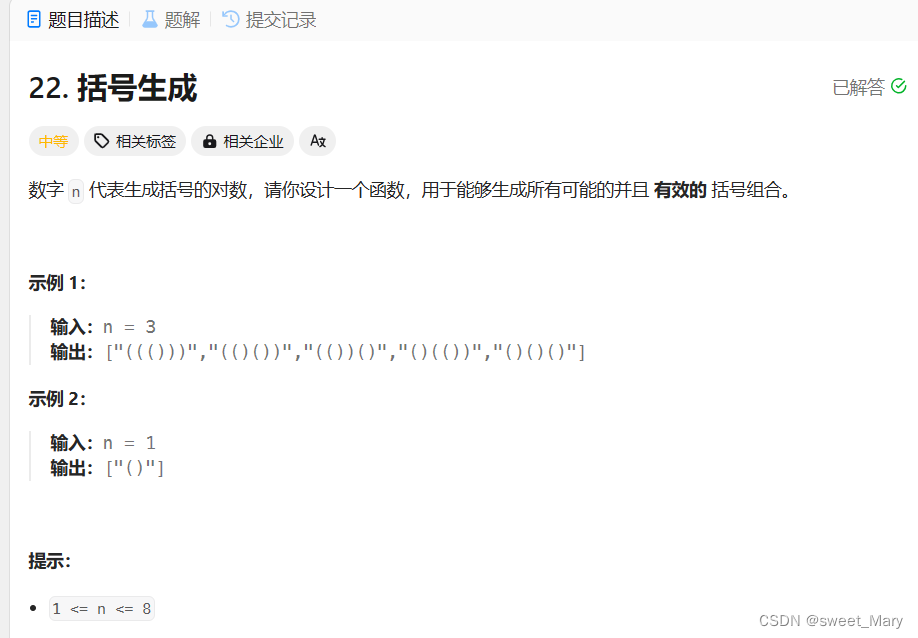
暴力--二进制
采用与:力扣---子集---回溯(子集型回溯)---递归-CSDN博客 中二进制求解一样的思路,即遍历0~
-1(从二进制去考虑),如果这个数的第 i 位为0,则括号的第 i 位为‘( ’,为1代表‘ )’。依次求出所有括号的可能性(总共
种可能),再对每种情况进行判别。
代码:
C++:
class Solution {
public:bool check(string temp,int n){stack<char> s;int num=2*n;for(int i=0;i<num;i++){//先判断是否配对if(temp[i]=='('){s.push(temp[i]);}else{if(s.empty()){return false;}else{s.pop();}}}if(s.empty()){return true;}else{return false;}}vector<string> generateParenthesis(int n) {vector<string> res;int temp=2*n;for(int i=0;i<(1<<temp);i++){ //0代表(,1代表)string s;for(int j=0;j<temp;j++){if(i & (1<<j)){s+=')';}else{s+='(';}}//cout<<s<<endl;if(check(s,n)){res.push_back(s);}}return res;}
};Python:
class Solution:def generateParenthesis(self, n: int) -> List[str]:def check(temp:str,n:int) -> bool:s=deque()num=2*nfor i in range(num):if temp[i]=='(':s.append(temp[i])else:if len(s)==0:return Falseelse:s.pop()if len(s)==0:return Trueelse:return Falseres=[]temp=2*ntemp_=1<<tempfor i in range(temp_):s=""for j in range(temp):if i & (1<<j):s+=')'else:s+='('if check(s,n):res.append(s)return res注意:len(s)用于查看队列/栈中元素的个数,string在Python中的写法为str,Python中栈和队列都可以用deque来实现。deque:from collections import deque
暴力--回溯dfs
采用与:力扣---子集---回溯(子集型回溯)---递归-CSDN博客 中递归法一样的思路,分为三个步骤,第一步骤为特殊情况的判别,即
个位置已经填满,对其进行判别。第二步骤为第 i 为设置为‘(’,进行递归调用(注意保护现场)。第三步骤为第 i 为设置为‘ )’,进行递归调用(注意保护现场)。
代码:
C++:
class Solution {
public:bool check(string temp,int n){stack<char> s;int num=2*n;for(int i=0;i<num;i++){//先判断是否配对if(temp[i]=='('){s.push(temp[i]);}else{if(s.empty()){return false;}else{s.pop();}}}if(s.empty()){return true;}else{return false;}}void dfs(int i,vector<string>& res,string temp,int n){if(i==2*n){if(check(temp,n)){res.push_back(temp);}return;}//将'('加入temptemp+='(';dfs(i+1,res,temp,n);temp.pop_back();//将')'加入temptemp+=')';dfs(i+1,res,temp,n);temp.pop_back();}vector<string> generateParenthesis(int n) {vector<string> res;string temp;dfs(0,res,temp,n);return res;}
};Python:
class Solution:def generateParenthesis(self, n: int) -> List[str]:def check(temp:str,n:int) -> bool:s=deque()num=2*nfor i in range(num):if temp[i]=='(':s.append(temp[i])else:if len(s)==0:return Falseelse:s.pop()if len(s)==0:return Trueelse:return Falsedef dfs(i:int,res:List[str],temp:str,n:int):if i==2*n:if check(temp,n):res.append(temp)returntemp+='('dfs(i+1,res,temp,n)temp=temp[0:len(temp)-1]temp+=')'dfs(i+1,res,temp,n)temp=temp[0:len(temp)-1]res=[]temp=""dfs(0,res,temp,n)return res对第二种写法的优化:
我们需要认识到一个点,遍历到第 i 位(即要确定第 i 位是左括号还是右括号时),前 i-1 位的左括号数量一定大于右括号的数量,第 i 位才可能是‘ )’。所以我们可以在这部分进行改进:
//将')'加入temp temp+=')'; dfs(i+1,res,temp,n); temp.pop_back();同时,对特殊情况的判断也可以变为对左括号数量和对右括号数量的判断。
代码:
C++:
class Solution {
public://左括号数>右括号数,才能加右括号void dfs(int i,vector<string>& res,string temp,int n,int left,int right){if(i==2*n){if(left==right){res.push_back(temp);}return;}//将'('加入temptemp+='(';dfs(i+1,res,temp,n,left+1,right);temp.pop_back();//将')'加入tempif(left>right){temp+=')';dfs(i+1,res,temp,n,left,right+1);temp.pop_back();}}vector<string> generateParenthesis(int n) {vector<string> res;string temp;dfs(0,res,temp,n,0,0);return res;}
};Python:
class Solution:def generateParenthesis(self, n: int) -> List[str]:def dfs(i:int,res:List[str],temp:str,n:int,left:int,right:int):if i==2*n:if left==right:res.append(temp)returntemp+='('dfs(i+1,res,temp,n,left+1,right)temp=temp[0:len(temp)-1]if left>right:temp+=')'dfs(i+1,res,temp,n,left,right+1)temp=temp[0:len(temp)-1]res=[]temp=""dfs(0,res,temp,n,0,0)return res











)






